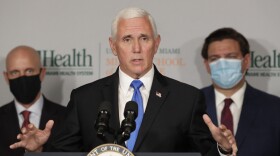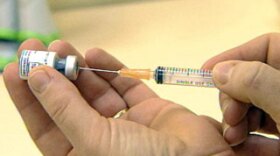Over half of the students enrolled in North Carolina public schools will be starting their school year at home this fall. Gov. Roy Cooper announced earlier this month that public schools can open through a Plan B or hybrid model, with some in-home and some face-to-face instruction, or with a Plan C model, with remote-only instruction.
As more districts are announcing their plans to move to online-only instruction, parentsŌĆÖ concerns over equity, access and work-education balance abound. Meanwhile, school districts adopting a Plan B model continue to field safety concerns from faculty and families alike.
Host Anita Rao talks to several guests about schoolsŌĆÖ fall reopening plans. is an EdNC reporting fellow and the incoming editor-in-chief of The Daily Tar Heel. is the superintendent of Iredell-Statesville Schools. is the superintendent of Durham Public Schools. is the superintendent of the Wake County Public School System. is the principal of Lake Norman Elementary School. And is a sociologist and a professor in the University of North Carolina at Chapel Hill School of Education.
What Shape Public School Plan Bs Might Take
Though most North Carolina public schools have announced a remote-only start for the upcoming school year, some districts are planning to implement hybrid models. Iredell County has a relatively low rate of positive COVID-19 cases, with 1,661 total reported cases and 16 reported deaths. Its school district, Iredell-Statesville, is planning for kindergarten through eighth grade students to attend school in person on an alternating day schedule.
Tilley, principal of Lake Norman Elementary, explains, ŌĆ£Kids would come for two days. One group of kids would come for two days, on Monday and Tuesday. And then the second half would come Thursday, Friday. And when those kids are not at the building, they are remote. Wednesday is designated a remote day for all and deep cleaning day, as well as Friday after school.ŌĆØ
She says, at least for her own children who are both students at Lake Norman Elementary: ŌĆ£When the decision was made, our kids looked to us for that reaction. And before I could even make that reaction, my kids were like: Yes, I am excited! They were excited about the smaller groups.ŌĆØ
Iredell-Statesville Superintendent Jeff James notes that their Plan B will only remain in progress as long as it is safe. ŌĆ£As more and more metrics come in, if there happened to be a significant spike in the county, I'm sure the board and I would sit down again and look at the data and, you know, possibly come up with a different decision,ŌĆØ he says. ŌĆ£We're not saying this is set in stone. We feel like we at least need to get kids back to some form of normalcy back into their lives ŌĆ” And if we see a spike or outbreak start and we feel it's detrimental, then we'll make that hard decision, most likely to go to Plan C.ŌĆØ
What Durham Public Schools Are Planning For Fall
After an initial Plan B announcement at the beginning of July, DPS Superintendent Pascal Mubenga amended the districtŌĆÖs plan to remote-only after fielding concerns from teachers and parents. Though remote-only will require unique accommodations for DurhamŌĆÖs low-income and special needs families, Mubenga feels confident that DPSŌĆÖs Plan C will provide space for various learning styles.
ŌĆ£We really have a schedule that's going to be synchronized, as well as synchronized learning. And we are very mindful, going from Pre-K all the way to 12. There are going to be some grade levels that will be engaged for two hours maximum a day. And then there are going to be some other grade levels that will be involved five hours a day,ŌĆØ Mubenga explains. ŌĆ£So we're not going to be throwing those kids out there for six or seven hours to screen time. So I think schedules are really well balanced so that our students will be able to meet the academic needs, as well as the social and emotional needs.ŌĆØ
What Wake County Public Schools Are Planning For Fall
Wake County Public School System Superintendent Cathy Moore is also being very thoughtful about her large school districtŌĆÖs needs, as WCPSS prepares to implement its own Plan C.
ŌĆ£In the spring, there wasn't a formal way to take attendance. Remote learning was encouraged by districts, but not required. Grades were not issued. And we were, quite frankly, in crisis management at that point in time,ŌĆØ says Moore. ŌĆ£So what we've had an opportunity to do as we've worked through the summer, is contemplating the potential to really open with having to start with remote instruction. We now have some systems and structures around required time that students may be online and expect to see teachers, so that we provide a more consistent academic experience and face time with teachers from what was done last spring. There will be assessments and assignments will be graded. There will be a higher expectation of accountability for both the teachers and students with attendance, as well.ŌĆØ
What Parents Can Do To Help One Another Through A Remote-Only Fall
When schools first closed in the spring, working parents struggled to balance childcare, homeschooling and their job demands. As remote-only education endures into fall, some parents are looking to partner with their neighbors and friends to create learning pods.
Sociologist and professor Thad Domina says, ŌĆ£A learning pod refers to one of many, many different arrangements that families are sort of scrambling to make, to deal with at least three different challenges that remote-only instruction presents to them. You know, one challenge is that with remote-only instruction, I think it's right for parents to worry that their children may not have the instructional support they need to manage their time and to get through the day. It's going to be hard. Parents are going to worry about childcare so that they can do their work. And then parents are going to worry about the opportunities for social interaction when kids are going to school atomized in their home via remote instruction.ŌĆØ
He notes, however, that learning pods will only work for families with some extent of privilege, as it would require at least one parentŌĆÖs ability to work from home all week and to hire outside help, if necessary, to supplement instruction. Domina believes it widens educational inequities, noting that attending public schools in person allows children from different socioeconomic backgrounds access to the same school-day resources ŌĆö a support they will lack while learning at home.
ŌĆ£One of the most important things about schooling and in particular public schooling is that it provides kids from all walks of our very diverse and very unequal society a common set of experiences, or at least a relatively common set of experiences, exposure to a set of shared values, shared sets of knowledge,ŌĆØ says Domina. ŌĆ£Shared socialization teaches us to lift the other. And it's hugely important. And so the risk to our democracy, to our social fabric, by having kids move out and spend a year or however long it's going to be in several separate learning environments ŌĆö is terrifying.ŌĆØ











